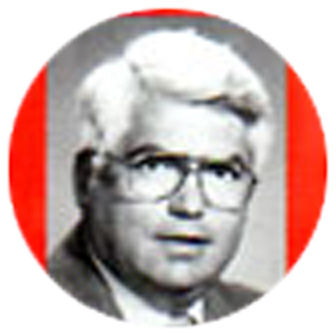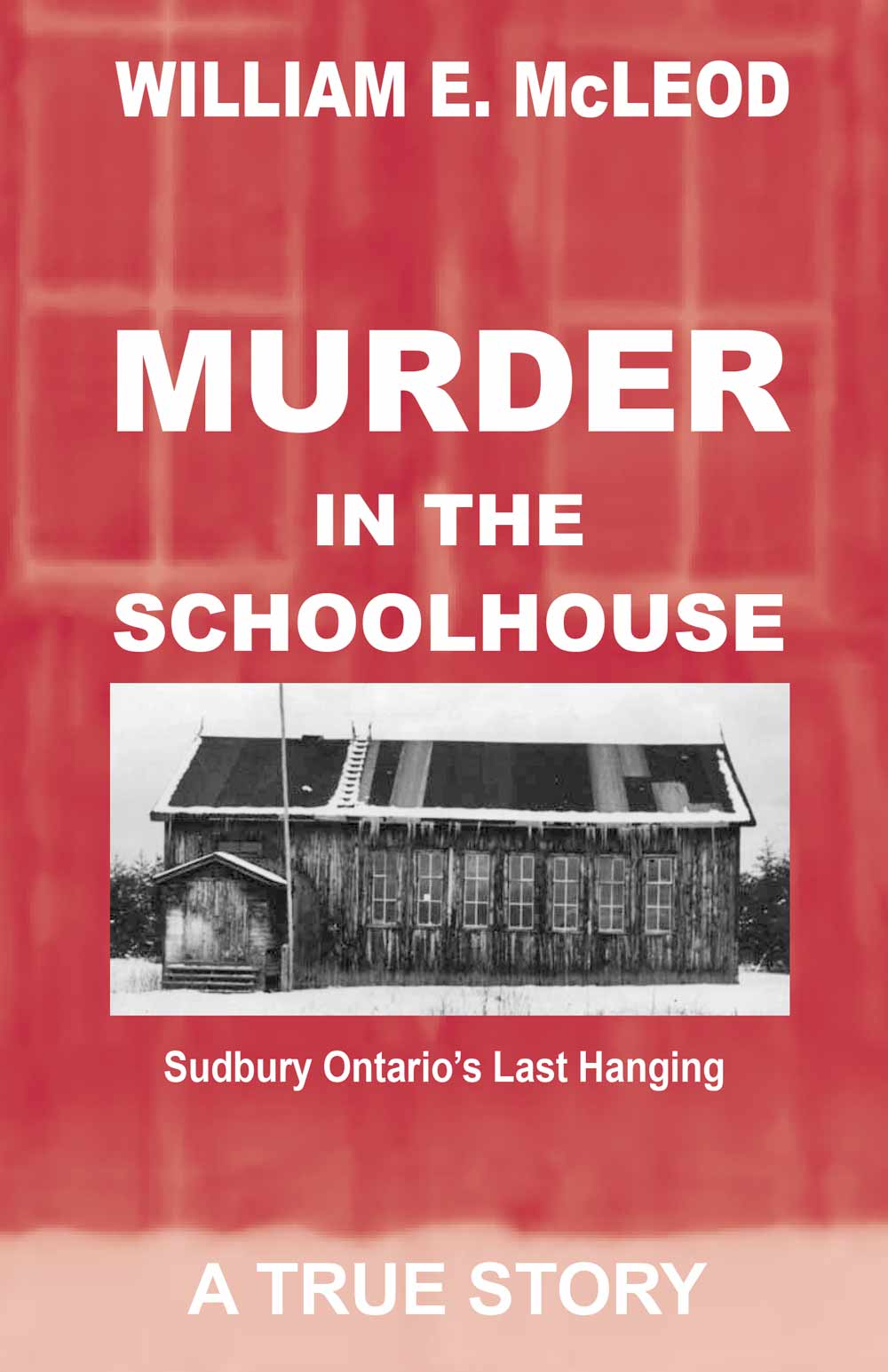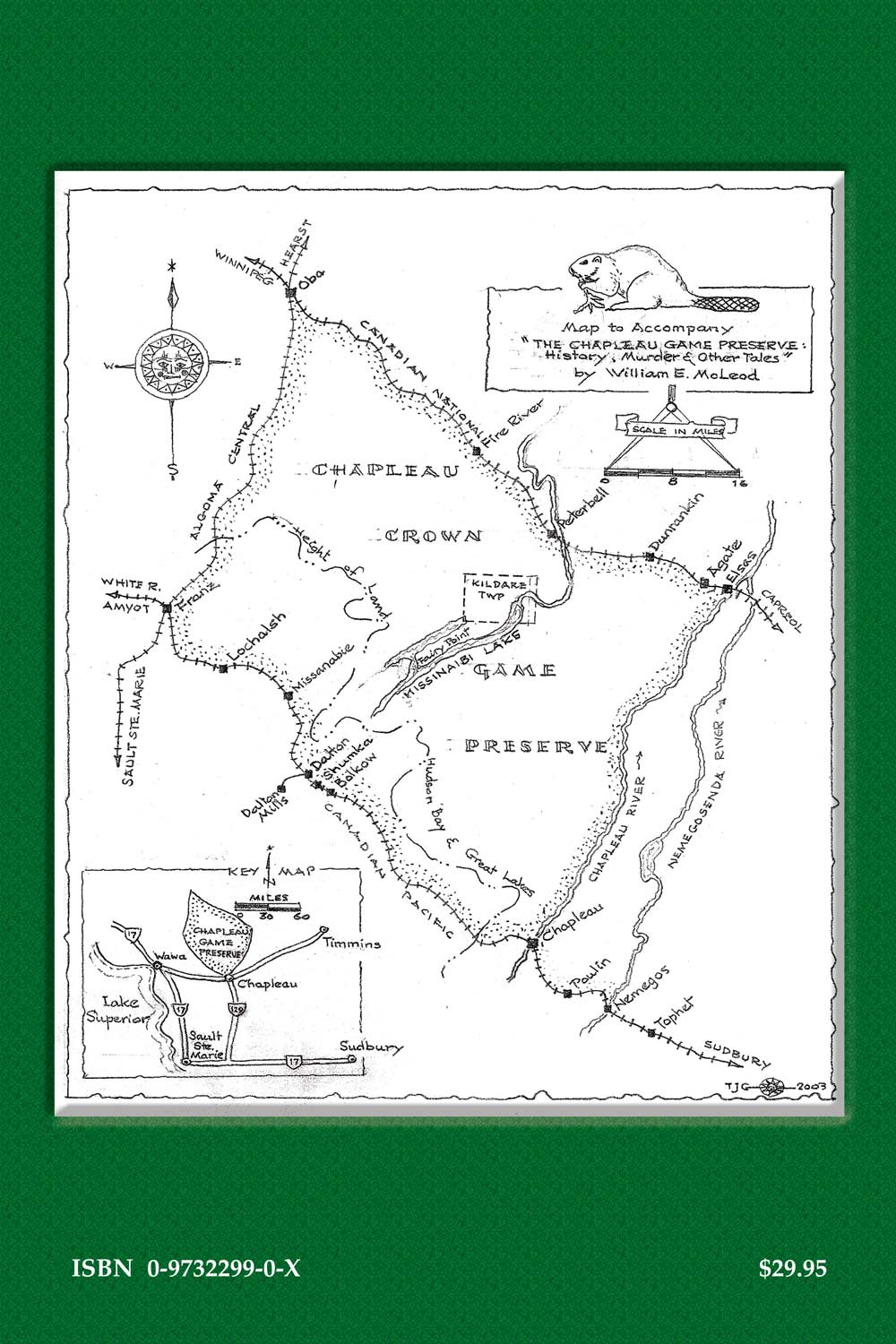The Chapleau Game Preserve: History, Murder and Other Tales
Synopsis
This book, released in 2004, is the first in a series of four books about the Chapleau area, written and published by the author.
The Chapleau Game Preserve is a 2,000,000 acre sanctuary where hunting, trapping and the possession of firearms have all been prohibited since 1925.
William McLeod (1872 – 1940) was a Chapleau merchant, fur trader and pioneer tourist outfitter who persuaded the Government of Ontario to set aside the Preserve. Mr. McLeod, grandfather of the author, was alarmed at the declining populations of fur bearing animals. He wrote a brilliant paper on the business of the fur trade that included numerous recommendations on how the fur trade could be rescued. Almost all of the recommendations were passed into law and they remain virtually unchanged nearly a century later.
Chapter Three covers the early years of the Game Preserve including the expulsion of the Brunswick House Band from the Preserve and what happened to them in subsequent years until 1973 when they were re-located in a new reserve at Duck Lake near Chapleau.
Subsequent chapters describe developments in the fur trade in northeastern Ontario and how the Game Preserve evolved over the years. It served its intended purpose and then gradually became a place where animals were live-trapped and relocated to other areas of Canada where the animal populations had dwindled. The Game Preserve eventually became a giant outdoor research laboratory and is now a popular eco-tourism and fishing destination.
The Murders and the Disappearance of George Weeden and Merle Newcombe
This section of the book describes six murders, a strange disappearance and the goofy goings on of a Sudbury fur buyer. For a small, isolated and sparsely populated region, there seems to have been an extraordinary number of violent crimes. The first victim was Jack McKee (1922), followed by Willie Saylors (1937), Dan Tessier (1946), Jack Hargis (1948), Steve Klapouschak (1954) and Erwin Stocken (1957). The killers of Jack McKee, Willie Saylors and Erwin Stocken were all charged with murder but were acquitted by juries. No one was ever charged with the murder of Dan Tessier. Two drifters were convicted of murdering Jack Hargis but their convictions were set aside by the Ontario Court of Appeal and they walked.
In the late fall of 1959, George Weeden and Merle Newcombe, two Chapleau railroaders, set out for Amyot, Ontario for a weekend of moose hunting. They were seen one day after arriving at Amyot and then disappeared off the face of the earth and, in spite of massive searches that fall and the next spring, they were never heard from again.
Fur Smuggling
Jacob Isaac "John" Glick was a fur buyer who operated out of Sudbury. In the spring of 1938, Glick and a number of accomplices accumulated a large booty of furs, many of which were probably illegally trapped inside the Chapleau Game Preserve. Glick was caught when trying to smuggle the furs out of the Northern Ontario wilderness and into Quebec. He also served time for the 1935 attempted murder of William Denomer of Oba, Ontario. Interesting man.
The Residential Schools and the Old Age Home
From about 1908 to 1948, two Indian Residential schools were located near Chapleau. Both were run by the Anglican Church. George Prewer who was principal of both schools for many years had a reputation for being a very harsh disciplinarian and stories of Prewer's beating of children appeared frequently in the files. When the church decided to close the school in 1948, some of Sudbury's politicians got the not so bright idea that they should ship Sudbury’s old people to Chapleau and house them in the recently closed Residential School. Thankfully, common sense prevailed and the school was sold to a private businessman and eventually demolished.
The Fires of 1948
It was impossible to search the newspapers for Chapleau stories without coming across numerous accounts of the terrible forest fires that turned much of Northern Ontario into a virtual inferno in the spring and early summer of 1948. There were actually three fires. Two separate fires that eventually joined burned a huge area from about 43 miles south of Chapleau well down into the Mississaugi River valley. The third fire started north of Chapleau and, at one point, it was feared that the town itself would burn. Fortunately, the rains came in time. After the fires it was imperative that every effort had to be made to harvest the partially burned timber before it was destroyed by insects. This necessitated the building of roads, the most important of which connected a road that stretched south from Chapleau about 40 miles to Horton Lake with the McFadden Lumber company roads that were used to service the company's lumber camps as far north as Aubrey Falls.
The Roads
For the first 63 years of its existence, Chapleau was without a road connection to the "outside" world. The only way in or out was by train and later by plane. That road connection was a political football in almost every provincial and federal election until well after World War II. Chapleau's isolation ended in the winter of 1949 when what would become Highway 129 was made passable enough for the people in Chapleau to drive south and connect with Highway 17.
Another road contention was the building of Highway 101 that eventually connected the communities of Timmins, Chapleau and Wawa. It was completed in the early 1960s.
The roads in the area are still an issue. Since the 1950s, there have been various lumber roads that connected Chapleau, Sultan, Ramsay and eventually Highway 144. The people of Chapleau have been lobbying the Provincial Government to take over some of these roads, and upgrade and pave them. The Provincial Government, for whatever reason, has resisted. Perhaps eventually they will relent and Chapleau folks will have a faster, safer and more modern access to Sudbury and points south. And motorists traveling to western Canada will be able to bypass the section of Highway 17 that runs from Sudbury to Wawa.
The Anecdotes
Much of the book deals with some pretty heavy duty history and times, people and events that were anything but pleasant. For that reason some lighter aspects of Chapleau's past seemed in order. Ten anecdotes that range from history to humor to whimsy make up this section of the book. For a complete list of the anecdotes, click on the Table of Contents link below.
If You Go
The book concludes with "If You Go" -- a travelogue of sorts. The drive from Thessalon to Chapleau along Highway 129, The Budd Car run on the C.P.R. between Sudbury and White River, canoeing in the Game Preserve, the historic town of Missanabie and the equally historic Missinaibi River, the C.N.R. trip to the village of Elsas and the characters who live and lived there make up the latter part of the book.
Table of Contents
PART I
Chapter 1 - Introduction
Chapter 2 - William McLeod - The Fur Trade in Northeastern Ontario and the Chapleau Game Preserve: William McLeod's Brief / Paper - Purposes - Problems - Proposed Solutions - The Game Preserve - Comment and Analysis
Chapter 3 - What Happened Next: The People - The New Brunswick House Indian Band - The Kildare Township Location - Elsas - Tophet - Three Alternatives - The Anglican Church - Vince Crichton's Paper: Some Interesting Points - The Survey - Three Initial Tasks - The Patrol Cabins
Chapter 4 - Enforcement and Poaching: The Early Years - The Thirties - Four Interesting Cases - Other Observations - Guns in the Lumber Camps - Poison - Poaching Ends - The Administration of "Justice"
Chapter 5 - The Winds of Change Begin to Blow: A Trappers' Association Begins to Form - New Trapping Regulations-Finally - The 1948 Meeting - The Winter of 1949 - An Old Idea Surfaces-Briefly - The 1950 Convention - The Old Order Changes
Chapter 6 - Other Historical Tidbits: Kapuskasing Station and Agate - Depression and War and Nothing Much Happens - Is the Game Preserve Too Large? - More on the Game Preserve Size - Another Committee -- Nuisance Beaver Bites the Dust - The Game Preserve Gets "Crown"ed - The Boundaries Stay the Same - The Wily Marten Multiplies - The Experimental Trapline - The Marten Goes to Patricia - Trapping-The beginning of the End? - Success Acknowledged
Chapter 7 - Four Purposes of The Game Preserve: Mining and Lumbering? - Scientific Studies - Dr. Martyn Obbard's Bear Study - Barnes and Mallik Research The Elk and the Caribou - The McNaught Elk - The A.C.R. Elk - The Caribou
PART II: MURDERS AND DISAPPEARANCES:
Chapter 8 - Jack McKee
Chapter 9 - Willie Saylors
Chapter 10 - Dan Tessier
Chapter 11 - Jack Hargis
Chapter 12 - Steve Klapouschak
Chapter 13 - Erwin Stocken
Chapter 14 - George Weeden and Merle Newcombe
Chapter 15 - Jacob Isaac Glick: Mr. Glick Goes to Elsas - Mr. Glick Goes to Oba
PART III
Chapter 16 - The Residential Schools and The Old Age Home: What to do with the Sudbury Elderly - The Finger of Lester Pearson Gets in the Pie - Who Should Pay? - Canon Redfern Louttit - Irene Hoff - A Tale of Two Bishops - Robert Renison - William Wright - What's It Going to Cost?
Chapter 17 - The Fires of 1948 - The June From Hell: Dave Souliere sees a Flying Saucer - The Election - The Chapleau Fire Precaution Group - The Price of Beer Goes Up After the Fires - What Did It All Cost? - The Salvage Operation - Ernie Morin Absconds with Jim Austin's Crew-An Anecdote - Could It Happen Again? - The Flaming Forests - Young Bush Pilot
Chapter 18 - The Roads: The Road as a Political Football - The North Bay Conference - The Election of 1935 - Trans Canada I - The Globe and Mail Goes to Chapleau - The Bubble Bursts-Slowly - Back to the Future - Trans Canada II - The Timmins Connection - The Ramsay Connection
PART IV
Chapter 19 - Anecdotes: On Becoming a Trapper - The Fur Buyer, The Vicar, and The Raid - Going to the Bank - Grey Owl and the Chapleau/McLeod Connection - How Some of the Aboriginals Got Their Names - Partridge Hunting at Poulin - The Sultan Poet - Chapleau's Uranium Mine - Chapleau and the Demon Rum - The School Cars
PART V
Chapter 20 - If You Go: Highway 129 - By Train - Canoeing in the Game Preserve - Elsas - Historic Missinaibi/Missanabie
PART VI
Chapter 21 - On Censorship and "Freedom" of Information
Chapter 22 - Conclusion
Appendix I
Why I wrote The Chapleau Game PreserveABOUT THE AUTHOR

William E. “Bill” McLeod is a retired Community College business professor.
He has published extensively in the fields of family finance and life insurance.
His latest book is about the Chapleau Residential Schools
Read more...




